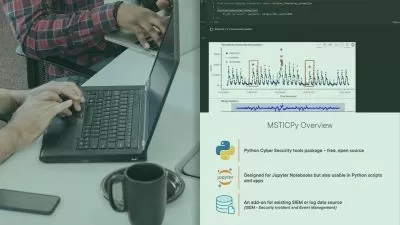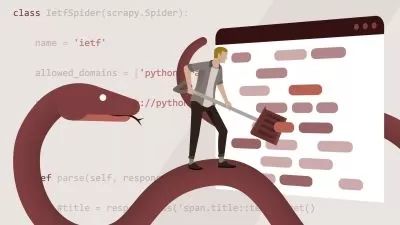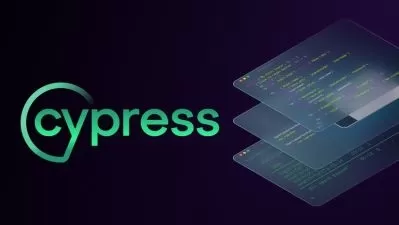Design & Build Test Framework with Python Pytest | API Tests
Kumar S
7:48:49
Description
Build Test Automation Framework with Pytest, Python Rest API Testing/Automation & SoftwareTesting/SDET/Architect Guide
What You'll Learn?
- Design & Building a Test Automation Framework from Scratch
- Test Automation With Python & Pytest
- Automated Software Testing With Python
- Software Test Framework modules and components
- Rest API Testing and Automation
- Effectively use Python and Pytest framework for Automation
- Writing better and structured test automation
Who is this for?
More details
DescriptionWelcome!
Test frameworks are tools that software developers and quality assurance professionals use to automate the process of testing software applications. These frameworks provide a set of predefined rules, guidelines, and features that help in organizing, executing, and reporting the results of the tests.
Some of the key features of test frameworks include the ability to define test cases, assertions, and fixtures, which are reusable components that simplify the process of testing. They also often provide integration with other tools, such as continuous integration and deployment (CI/CD) pipelines, to automate the testing process and improve the efficiency of the development process.
Test frameworks are typically designed to support different types of testing, including unit, functional, API, Usability, Integration and performance testing. They can also support different programming languages and platforms, allowing developers to choose the one that best suits their needs.
Examples of popular test frameworks include JUnit for Java applications, NUnit for .NET applications, and Pytest for Python applications. There are also specialized test frameworks available for specific types of testing, such as Selenium for web application testing and Appium for mobile application testing.
In this course we are going to learn how to Design and Build a Test Automation Framework. The underlying framework will be PYTEST and we will build a Hybrid kind of framework which will be:
Modular-Based,
Data-driven, & also
Library/Utils Driven Architecture.
This framework will be extensible and scalable where in you extend to any types of tests like e.g. DB testing, UI testing and others. We will structure our test project framework to be able to handle complex scenarios also.
Some of the modules or components we will have in our Hybrid Test Framework are as:
- Test Runner: This is the module responsible for executing tests and reporting the results. Pytest is what we will be using here, to take the benefits of Python.
- Utils/Library module: Will contain all reusable functions such as databases, generic functions, application functions etc.
- Config Management module: Separate config files and config manager to enable different config files.
- Data Management module: Should support Data Driven capability. Handle Scripts and Data separately.
- Logging & Reporting: Separate the logging code from the main code, making it easier to maintain and update the test code base.
These are some of the modules found in test frameworks we will talk about in this course. And also how to incorporate them in our framework and build a structured framework that will be easy to maintain and flexible enough to add new test scenarios or new functions.
Of-course the specific modules you need in your test framework will depend on the needs of your testing process, such as the types of tests you need to run, the technologies you're using, and the size and complexity of your testing infrastructure. But this course will give you a really good start towards your automation journey, and also make it easier for you to design a test automation framework.
After taking this course you will:
Have the skills and knowledge needed to build and implement a successful test framework that can improve the quality and reliability of software applications.
Be able to easily start adding test scripts functions and modules in a test framework.
Be able to design and build your own test framework from scratch.
Understand the components in any testing framework.
Be able to suggest changes to existing frameworks your team might be using.
Design organize your tests properly in any test automation project.
Learn API testing automation as well.
Be able to take test automation interviews easily.
And, Improve your career prospects
Finally, take another big step towards Test Architect.
Overall, taking the course on "Building a Test Framework" can be a great investment in your professional development and can help you build the skills and knowledge needed to succeed in the software industry.
Sign in and lets learn to build test automation frameworks and write tests in a structured way.
Thank you and see you in the course!
Tags: Python Test Framework, Pytest Framework Automation, API Testing, API Automation, Integration Testing, Software Testing
Who this course is for:
- Anyone who wants to learn software testing and automation
- Software development, testing, or quality assurance professionals curious about Test Frameworks
- Beginner to intermediate level test automation developers
- Anyone who wants to learn software test automation with Python
Welcome!
Test frameworks are tools that software developers and quality assurance professionals use to automate the process of testing software applications. These frameworks provide a set of predefined rules, guidelines, and features that help in organizing, executing, and reporting the results of the tests.
Some of the key features of test frameworks include the ability to define test cases, assertions, and fixtures, which are reusable components that simplify the process of testing. They also often provide integration with other tools, such as continuous integration and deployment (CI/CD) pipelines, to automate the testing process and improve the efficiency of the development process.
Test frameworks are typically designed to support different types of testing, including unit, functional, API, Usability, Integration and performance testing. They can also support different programming languages and platforms, allowing developers to choose the one that best suits their needs.
Examples of popular test frameworks include JUnit for Java applications, NUnit for .NET applications, and Pytest for Python applications. There are also specialized test frameworks available for specific types of testing, such as Selenium for web application testing and Appium for mobile application testing.
In this course we are going to learn how to Design and Build a Test Automation Framework. The underlying framework will be PYTEST and we will build a Hybrid kind of framework which will be:
Modular-Based,
Data-driven, & also
Library/Utils Driven Architecture.
This framework will be extensible and scalable where in you extend to any types of tests like e.g. DB testing, UI testing and others. We will structure our test project framework to be able to handle complex scenarios also.
Some of the modules or components we will have in our Hybrid Test Framework are as:
- Test Runner: This is the module responsible for executing tests and reporting the results. Pytest is what we will be using here, to take the benefits of Python.
- Utils/Library module: Will contain all reusable functions such as databases, generic functions, application functions etc.
- Config Management module: Separate config files and config manager to enable different config files.
- Data Management module: Should support Data Driven capability. Handle Scripts and Data separately.
- Logging & Reporting: Separate the logging code from the main code, making it easier to maintain and update the test code base.
These are some of the modules found in test frameworks we will talk about in this course. And also how to incorporate them in our framework and build a structured framework that will be easy to maintain and flexible enough to add new test scenarios or new functions.
Of-course the specific modules you need in your test framework will depend on the needs of your testing process, such as the types of tests you need to run, the technologies you're using, and the size and complexity of your testing infrastructure. But this course will give you a really good start towards your automation journey, and also make it easier for you to design a test automation framework.
After taking this course you will:
Have the skills and knowledge needed to build and implement a successful test framework that can improve the quality and reliability of software applications.
Be able to easily start adding test scripts functions and modules in a test framework.
Be able to design and build your own test framework from scratch.
Understand the components in any testing framework.
Be able to suggest changes to existing frameworks your team might be using.
Design organize your tests properly in any test automation project.
Learn API testing automation as well.
Be able to take test automation interviews easily.
And, Improve your career prospects
Finally, take another big step towards Test Architect.
Overall, taking the course on "Building a Test Framework" can be a great investment in your professional development and can help you build the skills and knowledge needed to succeed in the software industry.
Sign in and lets learn to build test automation frameworks and write tests in a structured way.
Thank you and see you in the course!
Tags: Python Test Framework, Pytest Framework Automation, API Testing, API Automation, Integration Testing, Software Testing
Who this course is for:
- Anyone who wants to learn software testing and automation
- Software development, testing, or quality assurance professionals curious about Test Frameworks
- Beginner to intermediate level test automation developers
- Anyone who wants to learn software test automation with Python
User Reviews
Rating
Kumar S
Instructor's Courses
Udemy
View courses Udemy- language english
- Training sessions 56
- duration 7:48:49
- Release Date 2023/03/29

















